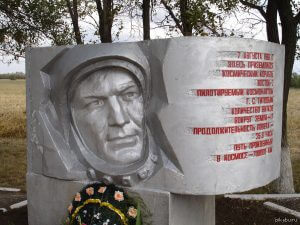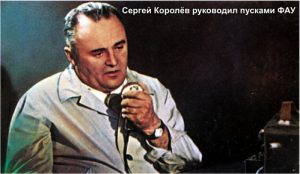
Russia: Kapustin Jar Soviet version of Area 51
 12
12
 14. 09. 2016
14. 09. 2016

One of the most mysterious places it has to do with UFO, is American Area 51 - a secret military base where the remains of an alien ship and the body of its pilot are allegedly stored. However, such a place is probably not the only one on Earth; there used to be a similar facility in the USSR. Or is it still in operation today?
The analogue of area 51 was allegedly object 754 in the USSR. Crashed cigar-shaped or plate-shaped machines were brought here.
Concealed military convoy
Kapustin Jar has a very interesting history, it began in 1946. Originally, the military training area was built on the orders of Stalin as a shooting range for V-2 missiles.
The Americans were the first to reach the German development center in Peenemünde. About 400 scientists, including Wernher von Braun, took almost all the documentation and dozens of rockets. The Soviets arrived second and brought home the rest of the team, the documents, and the remaining missiles they found there. Using these sources, the Russians built "their" first missiles.
As a polygon, a territory of 650 km was selected2, in the northwest of the Astrakhan region, about 100 kilometers from Volgograd, then Stalingrad, at the present border with Kazakhstan - on whose territory is today Baikonur. The first launch of the captured ballistic missile was made in 1947 under the leadership of Sergei Korolyov. The Americans fired the first V-2 missile in 1946. For 10 years, Kapustin Jar was the only missile range in the USSR.
In 1947, geophysical rockets began to take off from here, scientific instruments were added to the V-2, and later meteorological rockets began to be launched. In 1951, the first dog crew flew out. Between 1951 and 1962, 29 rocket launches were made from Kapustin Jaro, staffed by dogs, 8 of which were unsuccessful. In 1962, the first Kosmos-1 satellite was launched and Kapustin Jar became a spaceport from which the Kosmos satellites took off. Kapustin Jar, abbreviated to Kap Jar, has been subject to the highest level of secrecy since the very beginning of its existence.
Another secret space
Few people today know that Baikonur is not the first Soviet spaceport, before it was Kapustin Jar. But the fact that there was another, Krasny Kut, very few people know. Krasny Kut was a landing place and was located in the south of the Saratov region, also on the border with Kazakhstan. It was built in 1941 and in operation until 1991, when the Russian Ministry of Defense published a two-year plan to close some research institutions and facilities. Gagarin and Titov also landed in this area, taking off from Baikonur. Here, however, the question arises why the landing area was built 6 years before it was from where to take off, unfortunately I could not find the answer.
Near Krasnovo Kuta, in the underground premises of Berjozovka-2, an archive was supposed to be located (perhaps still is), which is still under secrecy and was first mentioned to the public in 1988. Some of the archival documents were made available at the time and in they stated that in 1954 UFOs repeatedly flew over the Saratov and Astrakhan areas, most often over Kapustin Jar. In the opinion of experts with an exploratory goal. After several attempts to force a UFO to land, one of them was attacked by several military fighters. At that time, the connection with the pilots was interrupted, the planes did not return to the base and the search for them ended in failure. According to government commission documents, a similar case also took place over Moscow in 1938.
Back to Kapustina Jar
In 1947, the first ballistic missile was launched from Kap Jar, and the following year, a silver cigar UFO appeared over the polygon. It was probably attracted by ongoing tests of new technology. It should be noted that at that time, most people in the ruling circles tended to see in all the "strange" phenomena the results of clandestine research by potentially hostile powers (not only on the Russian side). The fact that the Cold War began at that time did not contribute to this either.
When a silvery object appeared over the polygon in the summer of 1948, two MIGs-15 were sent to it. A UFO hit one of them with a beam of rays. The pilot of the second MIG made a turn, avoided the beams and attacked. A silvery cigar fell to the ground. A group of military experts went to the crash site to take care of the "enemy agent." However, when they arrived at the place, to their great surprise, they found out that it was not a foreign intelligence service and that the object itself was probably not of terrestrial origin. They carefully collected all the pieces of debris and took them to a specialized hangar on the polygon. Here, fragments began to be dealt with by scientists who were trying to uncover the principles of extraterrestrial technologies. Some sources state that they also took the pilot of a "cigar".
The story of the pilot affected by the MIG in a nutshell
On June 16, 1948, research pilot Arkady Ivanovich Apraksin conducted a test flight on a prototype of a new jet in the airspace near the town of Kapustin Jar. Suddenly he saw a strange object, similar to a huge cucumber, connected to the ground base, where they confirmed that the radars had also detected a "cucumber". Apraksin was ordered to approach the UFO and force him to land and, if necessary, use force. The pilot took a course on a flying object, today we would call it a cigar, which at that time began to fall and approached the ground. When the distance between them was 10 km, a conical beam of light flew out of the UFO, which then spread into a fan and hit the cabin, and Apraksin went blind for a short time. After regaining his sight, he found that none of the devices were working. A very experienced pilot managed to successfully deploy an almost uncontrollable machine and save the prototype for further use.
Storage of crashed UFOs andthe 754 object
 Since then, as soon as a UFO crash was recorded anywhere in the USSR, the wreckage has been transported to Cape Jar. The collection grew and in 1979 they began to build a multi-storey underground structure, which was designed not only for military nuclear physicists, but where various types of experiments and tests could be performed. The object has the designation No. 754.
Since then, as soon as a UFO crash was recorded anywhere in the USSR, the wreckage has been transported to Cape Jar. The collection grew and in 1979 they began to build a multi-storey underground structure, which was designed not only for military nuclear physicists, but where various types of experiments and tests could be performed. The object has the designation No. 754.
The 10 flight was built, reaching a depth of 50 meters and the length of each floor is 150 meters. In order for the crashed UFO to be transported, it led to the underground both the road and the railroad. On the surface you will see only a smaller hill from which the ventilation duct comes out.
Accelerated construction of Baikonur
It should be noted that the first man was originally planned to be launched from Kapustin Jaro, but a number of "strange" events in 1954 resulted in the government deciding to preserve the site for space research and speed up the construction of a new spaceport in Kazakhstan. steppes, Baikonur, evidenced by the minutes of the government meeting. At the same time, an archive of unexplained events (ANJA) was created at the Ministry of Defense.
The question arises again, so what was the archive in Berjozovka-2?
The rush was such that the dog Lajka (1957) and Yuri Gagarin (spring 1961) took off from the unfinished Baikonur spaceport.
Blue Bundle
In the 90s, the Ufological Association of Russia tried to clarify the extent to which the stories about object 754 correspond to the truth. The chairman of the association, former cosmonaut and aviator Pavel Romanovič Popovič, sent an official request to the KGB. Popovič was very interested in UFOs, he saw one of them with his own eyes, and since 1984 he has been a member of the Commission for Anomalous Atmospheric Phenomena of the USSR Academy of Sciences.
The requests, signed by astronaut "number 4", were complied with and they sent him an envelope with 124 pages of typescript. The documents show that object 754 does exist and contains, inter alia, five "captured" UFOs, of varying degrees of preservation: shot down in 1985 in the Kabardino-Balkaria in the Caucasus, a plate found in 1981 in Kazakhstan, 1992 shot down in Kazakhstan, also 1992 in Kyrgyzstan and the wreckage of a "cigar" from Estonia.
Re-conceal information
 Ufologists were thrilled, hoping to see tangible evidence of extraterrestrial visits soon. However, Russia, which was disintegrating in the 90s and in a state of confusing chaos, was "in order" before they managed to embark on an expedition. All other questions from ufologists were left unanswered and the Blue Volume was marked as a forgery.
Ufologists were thrilled, hoping to see tangible evidence of extraterrestrial visits soon. However, Russia, which was disintegrating in the 90s and in a state of confusing chaos, was "in order" before they managed to embark on an expedition. All other questions from ufologists were left unanswered and the Blue Volume was marked as a forgery.
Today, Kapustin Jar is again a military training area and dozens of military units are located in its vast territory. And there, somewhere deep underground, there may be UFOs stored, which gradually reveal their secrets to teams of scientists. When you ask someone in the army about facility 754 today, they answer very briefly: "No comment".
In conclusion, it is worth noting that Kapustin Jar states in his short story "Out of the Cradle" or "Out of the Cradle" by Arthur C. Clarke.





